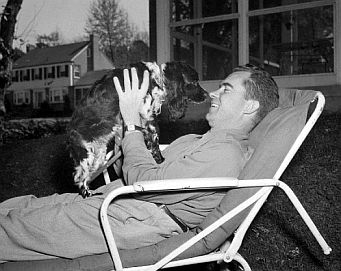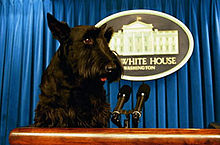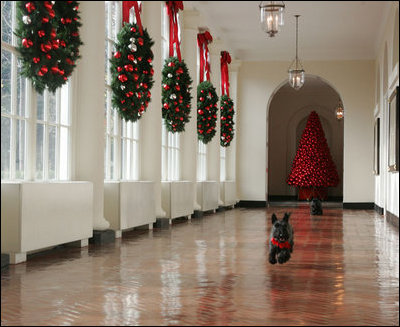When Barney Bush entered the White House in 2001, he probably did not know that he would soon have an annual job. The holiday season at the White House brings many visitors to parties and tours to view the decorations and the historical house. Not even a year in to President George W. Bush’s administration, the United States was attacked on September 11, 2001 by terrorists. The terrorist attacks fundamentally changed many of the White House’s security procedures, including how the holiday parties and decorations were handled. After the attacks, the administration had to figure out a way to showcase the holiday decorations without jeopardizing the security of the president. The White House was closed to visitors in 2001 and special precautions were taken the next year.
It was in a staff meeting that Internet Director Jimmy Orr casually mentioned the idea of having Barney do a video from his perspective that would give people a behind-the-scenes look at the White House decorations. Orr’s idea was not taken seriously at the meeting, but afterward got around to First Lady Laura Bush. She loved the idea and told the press. After the decision was made to produce a holiday video, Mrs. Bush set strict stipulations for the video; it must be silly for kids, funny for adults, and presidential.
The president and first lady were eager to find out how many viewers had watched the Barney Cam video after it was produced. The site had more than 24 million visitors the first day Barney’s video was on the White House website, the third highest amount of traffic directed at the site. Many news stations ran the seven-minute video in its entirety. The success of the video made it an annual tradition.
Each year the White House staff had to figure out ways to improve the Barney Cam video while keeping to Mrs. Bush’s requirements. Each year many familiar Washington faces and celebrities made cameo appearances. Subtle messages were also often included in the Christmas video to promote some of Mrs. Bush’s causes or make reference to political issues. The 2005 video, “A Very Beazley Christmas,” features a very upset Barney about the arrival and popularity of his new sister Miss Beazley. The wife of the vice president, Lynne Cheney, talks with Barney about his poll numbers in the presidential pets poll dropping. “Remember, poll numbers are just a snapshot in time,” she said in direct reference to the decline in the president’s poll numbers. In another scene, Barney walks into the library and passed a few carefully placed children’s books to reference the importance of literacy. The 2007 version of Barney Cam was titled, “Holiday in the National Parks,” and was also the theme of the White House Christmas decorations. That year, the Bush’s were highlighting the significance of the National Parks after the president announced a plan to invest more than $1 billion in the parks over the next decade. The president’s daughters, Barbara and Jenna Bush, talked to Barney and Miss Beazley about how important the National Parks are to the country. Mrs. Bush and National Parks Director Mary Bomar talked to Barney and Miss Beazley about becoming Junior Park Rangers and how they can help the National Parks.
The White House produced the annual holiday video every year until the end of Bush’s term. Even though the original intent of the video was to showcase the holiday decorations, it became a way to communicate with an audience that would not normally visit the White House website or that did not like the president. It showed viewers that the Bush’s and the White House staff were real people and could poke fun at their own situations.
Click here to see Barney's archived website.
Monday, July 19, 2010
Wednesday, July 14, 2010
Marines rescue kittens
The Washington Post recently featured a great story about about a group of Marines that rescued some kittens while serving in Afghanistan.
Kittens in Afghanistan rescued by Marines
Kittens in Afghanistan rescued by Marines
Labels:
animals in politics,
cats,
pets and politics,
pets in politics
Tuesday, July 13, 2010
Nixon and Checkers

Another dog, Checkers, is also often credited in aiding in his master’s political career. In September 1952, Senator and vice presidential candidate Richard Nixon faced allegations of accepting bribes and gifts during the campaign. A front page New York Times story charged that Nixon had a secret slush fund of $18,000 set aside for personal use. Nixon could see that his political future was in jeopardy and presidential candidate Dwight D. Eisenhower might remove him from the ticket. Fellow Republicans urged him to step down, while his advisors encouraged him to raise more money and buy television and radio airtime and confront the rumors. Nixon was able to raise enough money for airtime on 64 NBC television stations, 194 CBS radio stations, and 560 Mutual Broadcasting System radio stations at the cost of $75,000.

Nixon prepared his speech 24 hours in advance, but kept his remarks to himself and did not even let Eisenhower know what he was prepared to say. Nixon refused to rehearse or let the program director know the content of his remarks. Republican Party leader Dewey phoned shortly before going on and encouraged his resignation. Nixon proceeded anyway. He began the speech much like many other political speeches, “My Fellow Americans, I come before you tonight as a candidate for the vice presidency and as a man whose honesty and integrity has been questioned.” Nixon continued to talk and denied the allegations against him and told of his honest beginnings, but the turning point in the speech came when he invoked the newest family pet, Checkers.
“One other thing I probably should tell you, because if I don’t they’ll probably be saying this about me, too. We did get something, a gift, after the election.
A man down in Texas heard Pat on the radio mention the fact that our two youngsters would like to have a dog, and believe it or not, the day before we left on this campaign trip we got a message from Union Station in Baltimore, saying they had a package for us. We went down to get it. You know what it was?
It was a little Cocker Spaniel dog, in a crate that he had sent all the way from Texas, black and white, spotted, and our little girl Tricia, the six year old, named it Checkers.
And you know, the kids, like all kids, love the dog, and I just want to say this, right now, that regardless of what they say about it, we are going to keep it.” (watch the speech here)
When asked about the speech afterwards, Nixon said the idea to include Checkers in the speech came from Roosevelt’s speech about Fala. Many critics credit the “Checkers speech” as saving Nixon’s political career as vice president. Nixon historian, David Greenberg, noted “By invoking a dog that proved to be his best friend, Nixon sealed that role for television in politics.”
Monday, July 12, 2010
FDR's re-election & the Fala Speech
 On their return trip from Hawaii, President Roosevelt and Fala stopped to visit the Aleutian Islands. Their secret stop at Adak Island became highly scrutinized. A rumor was started that Fala had been accidently left behind on another island and the president sent at Navy destroyer ship back to get Fala for a cost of $20,000 at the taxpayers’ expense. The event became highly publicized during the 1944 presidential campaign and Republicans accused the president of spending millions of taxpayer dollars to fetch the little dog. The president confronted the allegations and defended his little dog during a campaign dinner speech to the International Brotherhood Teamsters Union, which was supposed to be an update on labor issues and the war, but became famously known as the “Fala Speech”:
On their return trip from Hawaii, President Roosevelt and Fala stopped to visit the Aleutian Islands. Their secret stop at Adak Island became highly scrutinized. A rumor was started that Fala had been accidently left behind on another island and the president sent at Navy destroyer ship back to get Fala for a cost of $20,000 at the taxpayers’ expense. The event became highly publicized during the 1944 presidential campaign and Republicans accused the president of spending millions of taxpayer dollars to fetch the little dog. The president confronted the allegations and defended his little dog during a campaign dinner speech to the International Brotherhood Teamsters Union, which was supposed to be an update on labor issues and the war, but became famously known as the “Fala Speech”:“These Republican leaders have not been content with the attacks on me, or my wife, or on my sons. No, not content with that, they now include my little dog. Fala. Well, of course, I don’t resent attacks, and my family doesn’t resent attacks, but Fala does resent them. You know, Fala is Scotch, and being a Scottie, as soon as he learned that the Republican fiction writers in Congress and out had concocted a story that I had left him behind on the Aleutian Islands and sent a destroyer back to find him—at a cost to taxpayers of 2 or 3, or 20 million dollars—his Scotch soul was furious. He has not been the same dog since.” (watch the speech here)
Political pundits noted the “Fala Speech” as the turning point in the 1944 presidential election. The speech exposed the pettiness of the Republican’s allegations and degraded candidate Thomas Dewey. Shortly before the election, a New York Times columnist noted in an October 15, 1944 article that “what is difficult for some folks to understand is that Fala is no longer just a dog; he’s a personage.” He also explained that a White House visitor once saw a door open, heard the announcement of the president and watched a little friendly dog with his tail wagging, enter the room. The election was decided and Roosevelt won almost 54 percent of the popular vote.
Over the years, Fala traveled with the president and met many dignitaries. War time comic strips and newspapers often featured the little dog. During the Battle of the Bulge, American soldiers would ask each other the name of the president’s dog as a safeguard against German soldiers infiltrating American forces.

President Roosevelt died on April 12, 1945, two months before Germany surrendered in World War II. Fala was at his bedside when aids tried to revive the president, but their efforts were unsuccessful.
Some articles suggest that Fala knew what was going on and reacted harshly. “He leaped up, shaking violently, then went crashing through a screen door, barking loudly and frantically. As fast as his scrubby legs could take him, he raced up a nearby hill, where for a long time he stood vigil, refusing to return when called,” one article said. Fala attended the funeral and then went to live with Eleanor at the Vall Kill cottage, in Hyde Park, New York. Fala later died on the seventh anniversary of Roosevelt’s death in 1952 and was buried next to his master in an unmarked grave that reads, “master and constant companion for five years.” Fala’s obituary appeared on the front page of the New York Times Obituary section several days after his death. The announcement noted, “the rakish little black Scotty who sat in on the making of history…” When the Roosevelt memorial was built and dedicated in 1997, Fala was included, sitting next to his master. He is the only dog memorialized on the National Mall in Washington, D.C.
Labels:
animals in politics,
dogs,
Fala,
pets and politics,
presidential pets
Subscribe to:
Posts (Atom)



